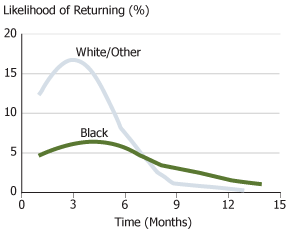
Who Returned to New Orleans After Hurricane Katrina?
Date
July 11, 2010
Author
(July 2010) Hurricane Katrina displaced almost the entire population of New Orleans in August 2005, scattering residents across the region, state, and country. By the fall of 2006, almost half the residents had returned, and almost two-thirds had returned by the fall of 2007. The article, “Race, Socioeconomic Status, and Return Migration to New Orleans After Hurricane Katrina,” published in Population and Environment in 2010 looked at how the pace of return varied by race and socioeconomic status, using data from a representative sample of pre-Katrina New Orleans residents in an innovative pilot survey—Displaced New Orleans Residents Pilot Survey (DNORPS)—developed and conducted by the RAND Corporation.
The Pace of Return to New Orleans Varies for Blacks and Whites

Source: RAND Corporation, Displaced New Orleans Residents Pilot Survey (DNORPS).
Blacks Bore the Brunt of the Disaster
New Orleans has always had a substantial black population, although historically it was the least segregated large American city.1 But by 2000, the standard index of black-white segregation showed New Orleans to have reached—and even exceeded—the national average.2 By the time Hurricane Katrina struck, almost all the extreme-poverty neighborhoods in New Orleans were predominantly black, and these racially and economically segregated areas bore the brunt of the disaster. A block-by-block analysis of census data and flood maps revealed that about half of the city’s white residents experienced serious flooding, compared with three-quarters of black residents.3 The disproportionate impact of Hurricane Katrina on the black and low-income residents of New Orleans has been widely discussed in other research.4
Blacks Have Had a Slower but Steadier Return Than Whites
Both blacks and whites have returned to the city, but our research showed that the pace of return differs between the two groups. The pace of return among blacks was much slower, but more steady, than for whites. For whites, the likelihood of returning peaked three months after Katrina and declined rapidly over the subsequent six months. It remained close to zero for whites nine months after the hurricane (May 2006), indicating that few, if any, whites who had not returned to the city by that time were likely to do so.
For blacks, however, the likelihood of returning peaked at about five months following the hurricane and declined relatively modestly over the subsequent months. By the end of the study period, the likelihood of returning for displaced blacks, although low, was considerably higher than for whites, indicating that blacks continued to return to the city in small numbers. We also found that those with college degrees returned to the city more quickly than those without degrees.
Housing Damage Accounts for Most of the Return Rate Differences
Why the difference? Our analysis showed that the level of housing damage largely accounts for the race disparities in return rates, as opposed to a person’s socioeconomic status or characteristics such as age, sex, marital status, employment, and housing tenure. In other words, blacks were less likely to return to New Orleans because they were more likely to have had their dwelling severely damaged or destroyed by flooding associated with Hurricane Katrina.
Elizabeth Fussell is an associate professor in the Sociology Department at Washington State University and an adjunct in the Tulane School of Public Health and Tropical Medicine. Narayan Sastry is a research associate professor in the Population Studies Center at the University of Michigan, and an adjunct senior social scientist at RAND. Mark VanLandingham is the Thomas C. Keller Professor in the Department of International Health and Development at Tulane University and an adjunct senior social scientist at RAND.
References
- Daphne Spain, “Race Relations and Residential Segregation in New Orleans: Two Centuries of Paradox,” Annals of the American Academy of Political and Social Science 441, no. 1 (1979): 82-96; and Elizabeth Fussell, “Constructing New Orleans, Constructing Race: A Population History of New Orleans,” Journal of American History 94, no. 3 (2007): 846-55.
- Lewis Mumford Center for Comparative Urban and Regional Research, Ethnic Diversity Grows, Neighborhood Integration Lags Behind (Albany, NY: State University of New York at Albany, 2001).
- D.L. Brazile, New Orleans: Next Steps on the Road to Recovery in the State of Black America (Washington, DC: National Urban League, 2006).
- For example, see the following: David L. Brunsma, David Overfelt, and J. Steven Picou, The Sociology of Katrina: Perspectives on a Modern Catastrophe (Lanham, MD: Rowman and Littlefield, 2007); James R. Elliott and Jeremy Pais, “Race, Class, and Hurricane Katrina: Social Differences in Human Responses to Disaster,” Social Science Research 35 (2006): 295-321; William W. Falk, Matthew O. Hunt, and Larry L. Hunt, “Hurricane Katrina and New Orleanians’ Sense of Place: Return and Reconstitution or ‘Gone with the Wind’?” DuBois Review 3 (2006): 115-28; Chester Hartman and Gregory Squires,There Is No Such Thing as a Natural Disaster: Race, Class and Katrina (New York: Routledge, 2006); Kristen Lavelle, and Joe Feagin, “Hurricane Katrina: The Race and Class Debate,” The Monthly Review 58, no. 3 (2006): 52-66; John R. Logan, “The Impact of Katrina: Race and Class in Storm-Damaged Neighborhoods,” working paper, Spatial Structures in the Social Sciences, Brown University, 2006; and Patrick Sharkey, “Survival and Death in New Orleans: An Empirical Look at the Human Impact of Katrina,” Journal of Black Studies 37, no. 4 (2007): 482-501.
